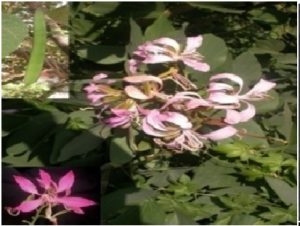|
Division
|
Angiosperms |
|
Class
|
Dicotledons |
|
Subclass
|
Polypetalae |
|
Series |
Calyciflorae |
|
Order |
Rosales |
|
Family |
Caesalpiniaceae |
|
Genus |
Bauhinia |
|
Species |
purpurea |

|
Etymology:
|
Bauhinia was created in honour of the brothers Jean and Casper Bauhin. Most of the species have their leaves composed of two lobes, these two lobes were symbolic of the services the two brothers had rendered to science. |
|
Botanical name:
|
Bauhinia purpurea Linn. |
|
Local/Trade names: |
The Purple Bauhinia, Autumn Flowering Bauhinia |
|
Conservation status:
|
Commonly planted in gardens. |
|
Digonestic features: |
Leaves bilobed; flowering time October. |
|
Description: |
Moderate-sized tree. Bark ash coloured or dark-brown. Leaves 8-12 cm across, lobes separated from 1/3 to 1/2 their length from the tip. Flowers light purple, 4-6 cm long, in terminal and axillary, few-flowered corymb-like racemes. Pods 15-25 x 1.5-2 cm. Seeds 6-16, flat, oblong-ellipsoid. |
|
Phenology:
|
Fls. & Frts.: Sept.-Jan. |
|
Distribution:
|
Sub-Himalayan tracts, Assam, Meghalaya, Western Peninsula. Bangladesh. |
|
Where to see it: |
Medicinal Plant Garden. |
|
Uses: |
Roots carminative. Bark used in diarrhoea, also yields a fibre. Flower buds eaten as a pot-herb, also pickled; they are laxative and anthelmintic. Leaves used as fodder. Seeds yield a non drying fatty oil. Wood used for agricultural implements and matches; also suitable for rafters and scantlings. |
Chief Conservator of Forests & Chief Wildlife Warden is the Head of the Department. There is one post of Conservator of Forests & two posts of Deputy Conservator of Forests viz.